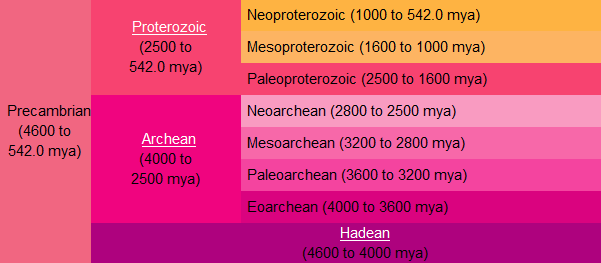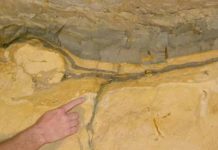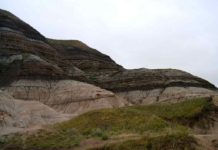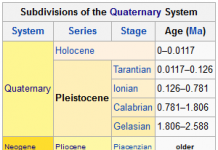The Neoproterozoic Era is the unit of geologic time from 1,000 to 541 million years ago.
The terminal Era of the formal Proterozoic Eon (or the informal “Precambrian”), it is further subdivided into the Tonian, Cryogenian, and Ediacaran Periods.
The most severe glaciation known in the geologic record occurred during the Cryogenian, when ice sheets reached the equator and formed a possible “Snowball Earth”.
The earliest fossils of multicellular life are found in the Ediacaran, including the earliest animals.
Geology
At the onset of the Neoproterozoic the supercontinent Rodinia, which had assembled during the late Mesoproterozoic, straddled the equator. During the Tonian, rifting commenced which broke Rodinia into a number of individual land masses.
Possibly as a consequence of the low-latitude position of most continents, several large-scale glacial events occurred during the Neoproterozoic Era including the Sturtian and Marinoan glaciations of the Cryogenian.
These glaciations are believed to have been so severe that there were ice sheets at the equator—a state known as the “Snowball Earth”.
Subdivisions
Paleobiology
The idea of the Neoproterozoic Era came on the scene relatively recently — after about 1960. Nineteenth century paleontologists set the start of multicelled life at the first appearance of hard-shelled animals called trilobites and archeocyathids.
This set the beginning of the Cambrian period. In the early 20th century, paleontologists started finding fossils of multicellular animals that predated the Cambrian boundary. A complex fauna was found in South West Africa in the 1920s but was misdated.
Another was found in South Australia in the 1940s but was not thoroughly examined until the late 1950s. Other possible early fossils were found in Russia, England, Canada, and elsewhere (see Ediacaran biota). Some were determined to be pseudofossils, but others were revealed to be members of rather complex biotas that are still poorly understood. At least 25 regions worldwide yielded metazoan fossils prior to the classical Cambrian boundary.
A few of the early animals appear possibly to be ancestors of modern animals. Most fall into ambiguous groups of frond-like organisms; discoids that might be holdfasts for stalked organisms (“medusoids”); mattress-like forms; small calcaerous tubes; and armored animals of unknown provenance.
These were most commonly known as Vendian biota until the formal naming of the Period, and are currently known as Ediacaran biota. Most were soft bodied. The relationships, if any, to modern forms are obscure. Some paleontologists relate many or most of these forms to modern animals. Others acknowledge a few possible or even likely relationships but feel that most of the Ediacaran forms are representatives of unknown animal types.
In addition to Ediacaran biota, later two other types of biota were discovered in China (the so-called Doushantuo formation and Hainan formation).
Terminal period
The nomenclature for the terminal period of the Neoproterozoic has been unstable. Russian geologists referred to the last period of the Neoproterozoic as the Vendian, while Chinese geologists referred to it as the Sinian, and most Australians and North Americans used the name Ediacaran.
However, in 2004, the International Union of Geological Sciences ratified the Ediacaran age to be a geological age of the Neoproterozoic, ranging from ~635 to 541.0 ± 1.0 million years ago. The Ediacaran boundaries are the only Precambrian boundaries defined by biologic Global Boundary Stratotype Section and Points, rather than the absolute Global Standard Stratigraphic Ages.











